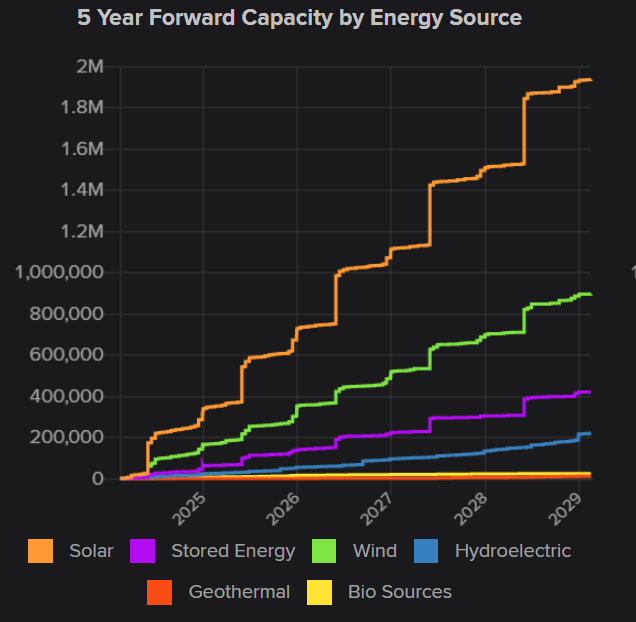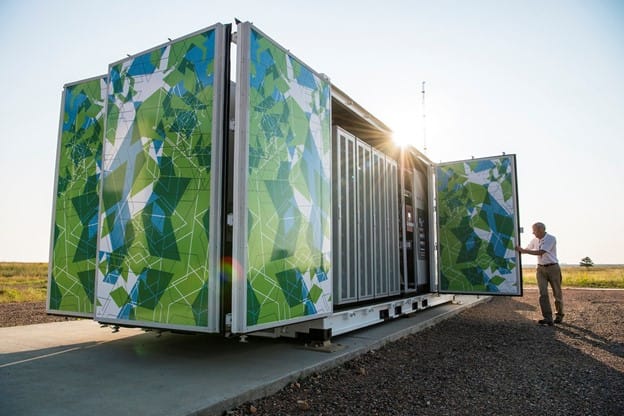Seize the Power: Ride the Energy Storage Surge
With exponential growth projected in energy storage, now's the time to invest. Let's harness this opportunity and create a brighter, more sustainable world together!

With exponential growth projected in energy storage, now's the time to invest. Energy storage solutions help phase out the need for fossil fuels to reach the global carbon emission reduction goals. In this newsletter, we'll delve into what energy storage is, the size of the market, future growth projections, environmental benefits, costs, technology applications, and government commitments and incentives—everything you need to know to make informed investment decisions.
What is Energy Storage & Why is it Valuable?
Energy storage involves capturing and storing energy for later use to provide an uninterrupted power supply. These systems store excess energy generated during times of low demand and release it during peak hours or when renewable energy sources like solar and wind are unavailable. For example, energy storage systems can reduce electricity costs by up to 30% through "peak shaving" and demand management, providing substantial savings for utilities and consumers alike.
Energy storage technologies come in various forms, including lithium-ion batteries, pumped hydro storage, and hydrogen fuel cells. These versatile solutions have applications across industries, from grid-scale deployments to electric vehicles and residential energy systems for a wide range of uses, such as:
- Grid Stabilization: Energy storage systems help stabilize the electricity grid by storing excess energy during periods of low demand and releasing it during peak hours. This helps maintain grid reliability and prevents blackouts.
- Renewable Integration: Energy storage enables the integration of intermittent renewable energy sources like solar and wind into the grid by storing excess energy generated during sunny or windy periods for use when the sun isn't shining or the wind isn't blowing.
- Peak Shaving: Energy storage systems can reduce the amount of electricity consumed from the grid during periods of peak demand by storing energy during off-peak hours when electricity prices are low and releasing it during peak hours when prices are high. This helps lower electricity costs for consumers and utilities.
- Backup Power: Energy storage systems provide backup power during grid outages or emergencies, ensuring critical facilities like hospitals, data centers, and telecommunications networks remain operational.
- Electric Vehicles (EVs): Batteries in electric vehicles serve as mobile energy storage systems, storing electricity to power the vehicle's electric motor. Energy storage technology advancements are extending EV range and reducing charging times. For peak vacation periods in prime travel routes in the United States temporary mobile supercharges (i.e. large-scale mobile batteries) are used to meet peak charging demands.
- Residential Energy Storage: Homeowners can install energy storage systems, typically in the form of lithium-ion batteries, to store excess energy generated by rooftop solar panels for use during the evening or when grid electricity prices are high.
- Microgrids: Energy storage systems play a crucial role in microgrid applications, allowing communities, campuses, or remote areas to operate independently from the main grid during grid outages or to optimize energy use and costs.
- Frequency Regulation: Energy storage systems provide rapid response capabilities to help regulate grid frequency, ensuring the balance between electricity supply and demand and maintaining grid stability.
In summary, energy storage technology offers a versatile solution to the challenges of modern energy management. From stabilizing the grid to integrating renewable sources and providing backup power, its applications span across industries and sectors. By harnessing the power of energy storage, we can achieve greater reliability, sustainability, and cost-effectiveness in our energy systems, paving the way for a more resilient and efficient future.
How do energy storage systems work? (video)
Size of the Market
The energy storage market is booming, with a projected value of over $500 billion by 2030. As the world transitions to renewable energy sources, the demand for reliable energy storage solutions is expanding. Energy storage capacity is expected to reach 5% of the total global renewable energy source by 2030.

Future Growth Projections
Experts predict exponential growth in the energy storage sector, driven by advancements in battery technology, declining costs, higher density and quality, and increasing government support. According to the International Renewable Energy Agency (IRENA), the deployment of energy storage is expected to grow exponentially, with the capacity reaching 22 terawatt-hours (TWh) by 2030. This means enough energy to power 220 million light bulbs for an hour! This is seen as the biggest ramp-up of capacity since the 1950's with 400 gigafactories for battery production, according to RMI.
Environmental Benefits & Costs
By enabling the integration of renewable energy sources into the grid and reducing reliance on fossil fuels, energy storage plays a crucial role in combating climate change and building a sustainable future. Some energy storage technologies, such as lithium-ion batteries, require the extraction of finite resources and pose environmental concerns related to mining, production, and disposal. However, with a focus on constant innovation and investment, experts believe there are enough raw materials that can be sourced equitably and sustainably. For example, the total annual extraction of battery minerals would weigh less than 1% of annual coal extraction today. As battery energy density has doubled over the past decade, the amount of materials needed per battery has halved. Similarly, the recent announcement of a new battery that does not require lithium, nickel, cobalt, or graphite is an example of such innovation in materials. Innovation in extending battery lifetime and recycling materials at end-of-life will support a sustainable future compared to fossil fuels.

Government Commitments and Incentives
Governments worldwide are ramping up commitments to combat climate change and promote clean energy solutions. Through incentives, subsidies, and regulatory support, policymakers are driving investment in energy storage infrastructure, reducing upfront costs, encouraging economies of scale, and creating a favorable environment for investors and job creation.
In the United States, the 2022 Inflation Reduction Act (IRA) represents the most significant legislation to invest in clean energy and climate change in the nation's history. It is estimated that more than 70% of that investment will be delivered through tax incentives. The Investment Tax Credit for energy storage projects offers a federal tax credit of up to 30% of the cost of eligible energy storage systems. Similarly, the European Union's Horizon Europe program has allocated €1 billion (approximately $1.15 billion) for research and innovation in energy storage technologies up to 2027.
Charged Up Investments
Act now and invest in the future of energy storage. With exponential growth projected in energy storage, seize this opportunity to shape tomorrow's energy landscape. Let's come together to create a brighter, more sustainable world.
Fun fact
The world's largest battery, the Hornsdale Power Reserve in South Australia, is capable of storing enough energy to power more than 30,000 homes for an hour! This massive battery system plays a crucial role in stabilizing the electricity grid and integrating renewable energy sources like wind and solar.
Free newsletter content
Twice a month with our newsletter distribution, we will discuss the market trends in one of our six themes below:
1. Renewable Energy (think solar, wind, hydroelectric)
2. Resources (think hydrogen)
3. Circular Economy (think water)
4. Energy Storage (think battery power grid)
5. Carbon Capture and Storage (think Carbon dioxide CO2 capture)
6. Green Transportation (think electric vehicles)
Premium newsletter summary
With paid Premium content, you can access our select investments now. They are ready to invest today with no minimum investment amounts and they are accessible in established liquid stock markets to easily buy or sell your investments at any time. Make it your monthly habit!
We also include their Environmental, social, and governance (ESG) score. The ESG data focuses on sustainability, diversity, human rights, license to operate, business ethics, and corporate governance. Using 630 metrics, ESG scores provide a comparison of a company's practices with their industry peers. The higher the score the better the company in their peer group.
Return Habit donates 2% of annual profits to underserved communities for green jobs and education. These jobs and training are critical for our community and economy.
